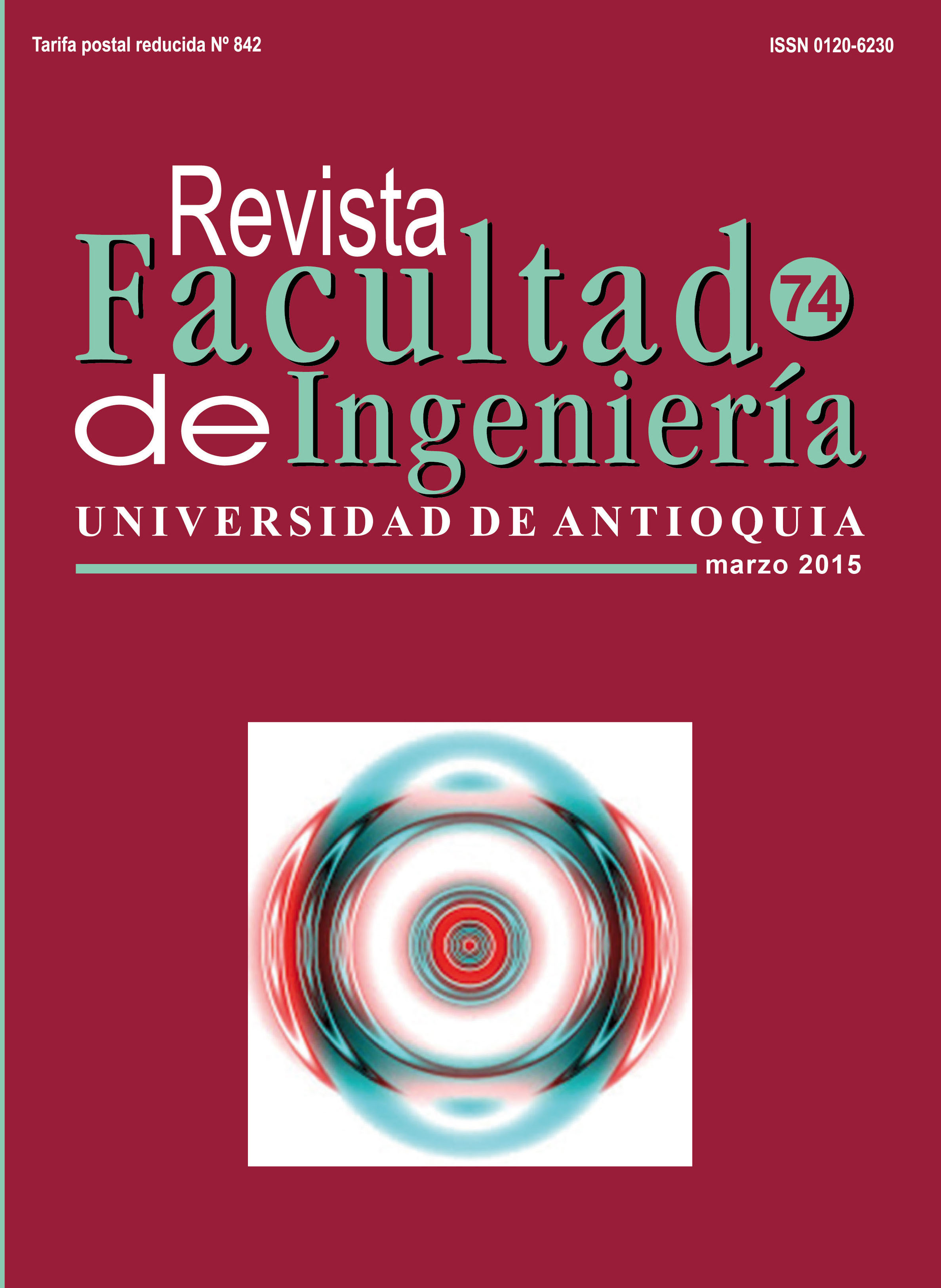Low complexity demodulator for BFSK waveforms based on polygonal approximation
DOI:
https://doi.org/10.17533/udea.redin.19422Keywords:
BFSK, digital demodulation, polygonal approximationAbstract
The present article relates in general to digital demodulation of Binary Frequency Shift Keying (BFSK waveform). The objective of the present research is to obtain a new processing method for demodulating BFSK-signals in order to reduce hardware complexity in comparison with other reported. The solution proposed here makes use of the theories of matched filters and curve segmentation. The article describes the integration and configuration of a Sampler Correlator and polygonal segmentation blocks in order to obtain a digital receiver for properly demodulating the signal received. The proposed solution is shown to reduce dramatically the complexity in hardware and has a better performance regarding noise in comparison with other reported. Theoretical details concerning limits of applicability are also given by closed-form expressions. Simulation experiments are illustrated to validate the overall performance.
Downloads
References
M. Lont, D. Milosevic, G. Dolmans, A. Roermund. “Implications of I/Q Imbalance, Phase Noise and Noise Figure for SNR and BER of FSK Receivers”. IEEE Trans. Circuits Syst. Regul. Pap. Vol. 60. 2013. pp. 2187-2198. DOI: https://doi.org/10.1109/TCSI.2013.2239151
K. Peng, C. Lin, C. Chao. “A Novel Three-Point Modulation Technique for Fractional-N Frequency Synthesizer Applications”. Radioengineering. Vol. 22. 2013. pp. 269-275.
I. Veřtát, J. Mráz. “Hybrid M-FSK/DQPSK Modulations for CubeSat Picosatellites”. Radioengineering. Vol. 2. 2013. pp. 389-393.
B. Sklar. Digital Communications, Fundamentals and Applications. 2nd ed. Ed. Prentice Hall. New Jersey, USA. 2001. pp. 124-125.
K. Farrell, P. McLane. “Performance of the crosscorrelator receiver for binary digital frequency modulation”. IEEE Trans. Commun. Vol. 45. 1997. pp. 573-582. DOI: https://doi.org/10.1109/26.592557
H. Kang, D. Kim, S. Park. Coarse frequency offset estimation using a delayed auto-quadricorrelator in OFDM-based WLANs. Proceedings of the 3rd International Congress on Ultra Modern Telecommunications and Control Systems and Workshops (ICUMT). Budapest, Hungary. 2011. pp. 1-4.
G. Ordu, A. Kruth, S. Sappok, R. Wunderlich, and S. Heinen. A quadricorrelator demodulator for a Bluetooth low-IF receiver. Proceedings of the IEEE Radio Frequency Integrated Circuits (RFIC) Symposium, Digest of Papers. Forth Worth, USA, 2004. pp. 351-354.
R. Yang, S. Chen, S. Liu. “A 3.125-Gb/s clock and data recovery circuit for the 10-Gbase-LX4 Ethernet”. IEEE J. Solid-State Circuits. Vol. 39. 2004. pp. 1356- 1360. DOI: https://doi.org/10.1109/JSSC.2004.831809
P. Egau. “Correlation systems in radio astronomy and related fields”. IEE Proceedings F, Commun. Radar Signal Process. Vol. 131. 1984. pp. 32-39. DOI: https://doi.org/10.1049/ip-f-1.1984.0007
T. Ahn, C. Yoon, Y. Moon. An adaptive frequency calibration technique for fast locking wideband frequency synthesizers. Proceedings of the 48th Midwest Symposium on Circuits and Systems. Vol. 2. Ohio, USA. 2005. pp. 1899-1902.
Y. Lee, T. Cheatham, J. Wiesner. “Application of Correlation Analysis to the Detection of Periodic Signals in Noise”. IRE. Vol. 38. 1958. pp. 1165-1171. DOI: https://doi.org/10.1109/JRPROC.1950.233423
J. Iñesta, M. Buendí, M. Sarti. “Reliable polygonal approximations of imaged real objects through dominant point detection”. Pattern Recognit. Vol. 31. 1998. pp. 685-697. DOI: https://doi.org/10.1016/S0031-3203(97)00081-2
Y. Zhu, L. Seneviratne. “Optimal polygonal approximation of digitised curves”. IEE Proc. Vis. Image and Signal Process. Vol. 144. 1997. pp. 8-14. DOI: https://doi.org/10.1049/ip-vis:19970985
P. Yin. “Ant colony search algorithms for optimal polygonal approximation of plane curves”. Pattern Recognit. Vol. 36. 2003. pp. 1783-1797. DOI: https://doi.org/10.1016/S0031-3203(02)00321-7
C. Fahn, J. Wang, J. Lee. “An adaptive reduction procedure for the piecewise linear approximation of digitized curves”. IEEE Trans. Pattern Anal. Mach. Intell. Vol. 11. 1989. pp. 967-973. DOI: https://doi.org/10.1109/34.35499
J. Sklansky, V. Gonzalez. “Fast polygonal approximation of digitized curves”. Pattern Recognit. Vol. 12. 1980. pp. 327-331. DOI: https://doi.org/10.1016/0031-3203(80)90031-X
D. Eu, G. Toussaint. “On Approximating Polygonal Curves in Two and Three Dimensions”. Cvgip Graph. Models Image Process. Vol. 56. 1994. pp. 231-246. DOI: https://doi.org/10.1006/cgip.1994.1021
K. Ku, P. Chui. “Polygonal approximation of digital curve by graduate iterative merging”. Electron. Lett. Vol. 31. 1995. pp. 444-446. DOI: https://doi.org/10.1049/el:19950319
B. Ray, K. Ray. “Determination of optimal polygon from digital curve using L1 norm”. Pattern Recognit. Vol. 26. 1993. pp. 505-509. DOI: https://doi.org/10.1016/0031-3203(93)90106-7
Y. Kurozumi, W. Davis. “Polygonal approximation by the minimax method”. Comput. Graph. Image Process. Vol. 19. 1982. pp. 248-264 DOI: https://doi.org/10.1016/0146-664X(82)90011-9
K. Wall, P. Danielsson. “A fast sequential method for polygonal approximation of digitized curves”. Comput. Vis. Graph. Image Process. Vol. 28. 1984. pp. 220-227. DOI: https://doi.org/10.1016/S0734-189X(84)80023-7
C. Williams. “An efficient algorithm for the piecewise linear approximation of planar curves”. Comput. Graph. Image Process. Vol. 8. 1978. pp. 286-293. DOI: https://doi.org/10.1016/0146-664X(78)90055-2
A. Oppenheim, R. Schafer. Discrete-time signal processing. 3rd ed. Ed. Prentice Hall. Upper Saddle River, USA. 2010. pp. 550-553.
A. Carlson, P. Crilly, J. Rutledge. Communication Systems: An introduction to Signals and Noise in Electrical Communication. 4th ed. Ed. McGraw-Hill. New York, USA. 2002. pp. 555-556.
Downloads
Published
How to Cite
Issue
Section
License
Copyright (c) 2018 Revista Facultad de Ingeniería

This work is licensed under a Creative Commons Attribution-NonCommercial-ShareAlike 4.0 International License.
Revista Facultad de Ingeniería, Universidad de Antioquia is licensed under the Creative Commons Attribution BY-NC-SA 4.0 license. https://creativecommons.org/licenses/by-nc-sa/4.0/deed.en
You are free to:
Share — copy and redistribute the material in any medium or format
Adapt — remix, transform, and build upon the material
Under the following terms:
Attribution — You must give appropriate credit, provide a link to the license, and indicate if changes were made. You may do so in any reasonable manner, but not in any way that suggests the licensor endorses you or your use.
NonCommercial — You may not use the material for commercial purposes.
ShareAlike — If you remix, transform, or build upon the material, you must distribute your contributions under the same license as the original.
The material published in the journal can be distributed, copied and exhibited by third parties if the respective credits are given to the journal. No commercial benefit can be obtained and derivative works must be under the same license terms as the original work.










 Twitter
Twitter